2014 FIAT 500L LIVING check engine light
[x] Cancel search: check engine lightPage 247 of 420
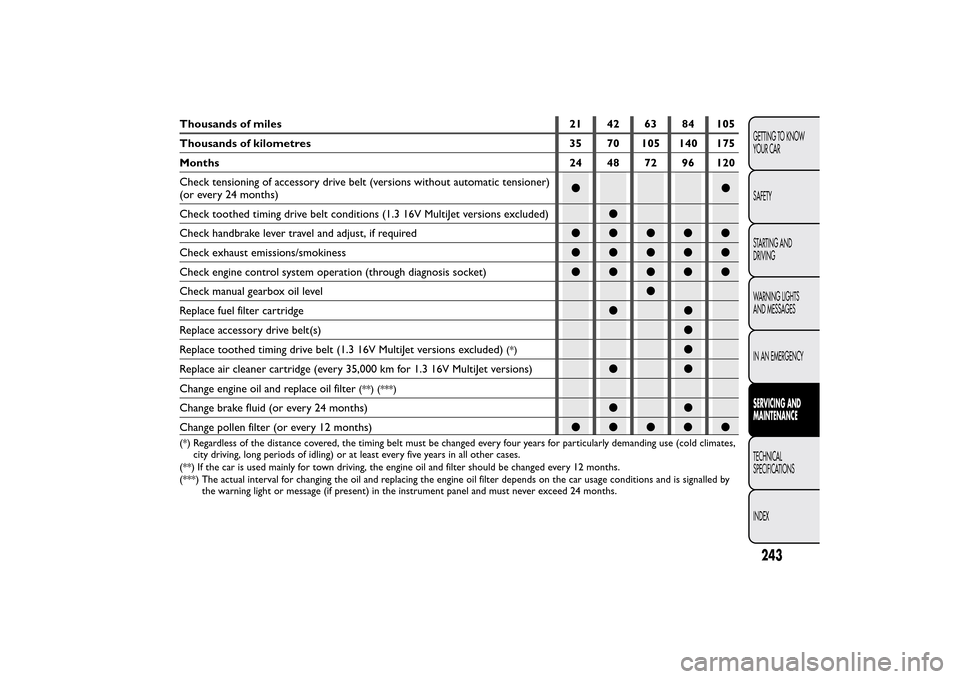
Thousands of miles 21 42 63 84 105
Thousands of kilometres 35 70 105 140 175
Months 24 48 72 96 120
Check tensioning of accessory drive belt (versions without automatic tensioner)
(or every 24 months)●●
Check toothed timing drive belt conditions (1.3 16V MultiJet versions excluded)●
Check handbrake lever travel and adjust, if required●●●●●
Check exhaust emissions/smokiness●●●●●
Check engine control system operation (through diagnosis socket)●●●●●
Check manual gearbox oil level●
Replace fuel filter cartridge●●
Replace accessory drive belt(s)●
Replace toothed timing drive belt (1.3 16V MultiJet versions excluded)
(*)
●
Replace air cleaner cartridge (every 35,000 km for 1.3 16V MultiJet versions)●●
Change engine oil and replace oil filter
(**) (***)
Change brake fluid (or every 24 months)●●
Change pollen filter (or every 12 months)●●●●●(*) Regardless of the distance covered, the timing belt must be changed every four years for particularly demanding use (cold climates,
city driving, long periods of idling) or at least every five years in all other cases.
(**) If the car is used mainly for town driving, the engine oil and filter should be changed every 12 months.
(***) The actual interval for changing the oil and replacing the engine oil filter depends on the car usage conditions and is signalled by
the warning light or message (if present) in the instrument panel and must never exceed 24 months.
243GETTING TO KNOW
YOUR CAR
SAFETY
STARTING AND
DRIVING
WARNING LIGHTS
AND MESSAGES
IN AN EMERGENCYSERVICING AND
MAINTENANCETECHNICAL
SPECIFICATIONS
INDEX
Page 248 of 420
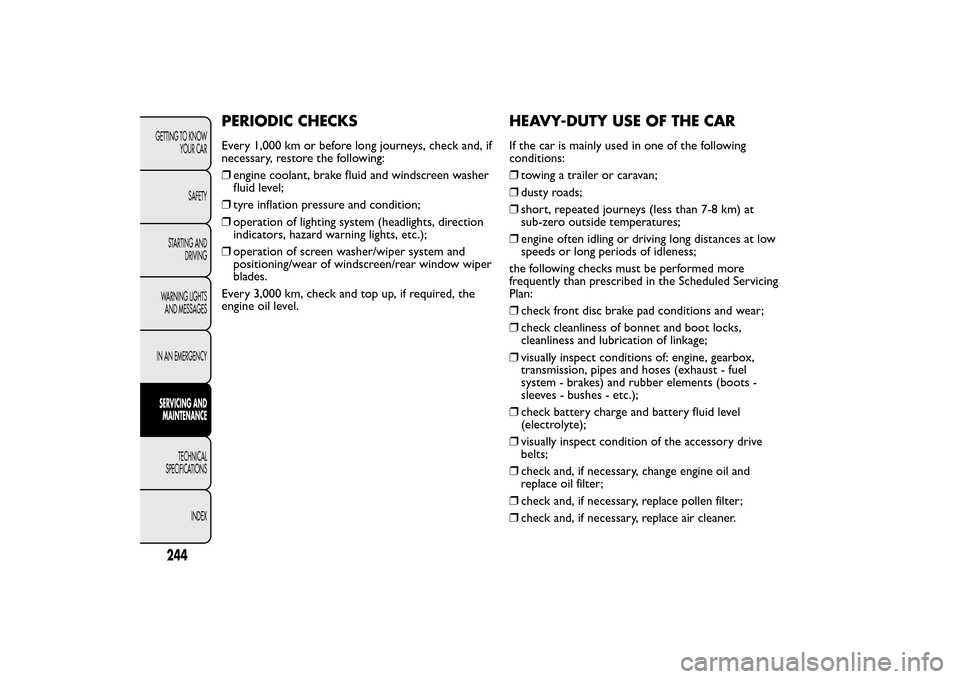
PERIODIC CHECKSEvery 1,000 km or before long journeys, check and, if
necessary, restore the following:
❒engine coolant, brake fluid and windscreen washer
fluid level;
❒tyre inflation pressure and condition;
❒operation of lighting system (headlights, direction
indicators, hazard warning lights, etc.);
❒operation of screen washer/wiper system and
positioning/wear of windscreen/rear window wiper
blades.
Every 3,000 km, check and top up, if required, the
engine oil level.
HEAVY-DUTY USE OF THE CARIf the car is mainly used in one of the following
conditions:
❒towing a trailer or caravan;
❒dusty roads;
❒short, repeated journeys (less than 7-8 km) at
sub-zero outside temperatures;
❒engine often idling or driving long distances at low
speeds or long periods of idleness;
the following checks must be performed more
frequently than prescribed in the Scheduled Servicing
Plan:
❒check front disc brake pad conditions and wear;
❒check cleanliness of bonnet and boot locks,
cleanliness and lubrication of linkage;
❒visually inspect conditions of: engine, gearbox,
transmission, pipes and hoses (exhaust - fuel
system - brakes) and rubber elements (boots -
sleeves - bushes - etc.);
❒check battery charge and battery fluid level
(electrolyte);
❒visually inspect condition of the accessory drive
belts;
❒check and, if necessary, change engine oil and
replace oil filter;
❒check and, if necessary, replace pollen filter;
❒check and, if necessary, replace air cleaner.
244GETTING TO KNOW
YOUR CAR
SAFETY
STARTING AND
DRIVING
WARNING LIGHTS
AND MESSAGES
IN AN EMERGENCYSERVICING AND
MAINTENANCE
TECHNICAL
SPECIFICATIONS
INDEX
Page 249 of 420
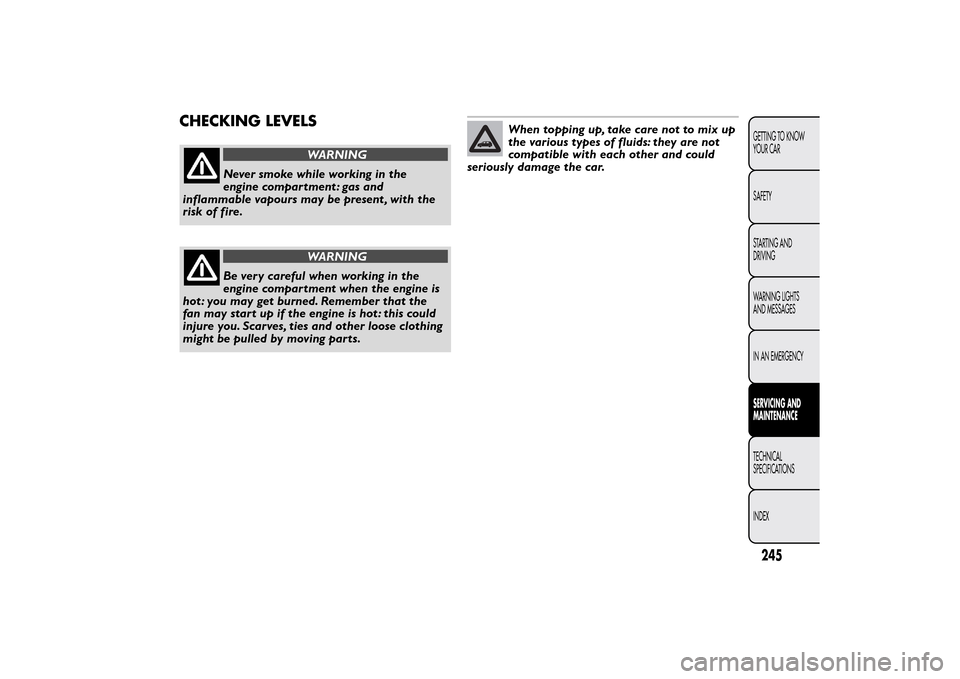
CHECKING LEVELS
WARNING
Never smoke while working in the
engine compartment : gas and
inflammable vapours may be present , with the
risk of fire.
WARNING
Be very careful when working in the
engine compartment when the engine is
hot : you may get burned. Remember that the
fan may start up if the engine is hot : this could
injure you. Scarves, ties and other loose clothing
might be pulled by moving parts.
When topping up, take care not to mix up
the various types of fluids: they are not
compatible with each other and could
seriously damage the car.
245GETTING TO KNOW
YOUR CAR
SAFETY
STARTING AND
DRIVING
WARNING LIGHTS
AND MESSAGES
IN AN EMERGENCYSERVICING AND
MAINTENANCETECHNICAL
SPECIFICATIONS
INDEX
Page 254 of 420
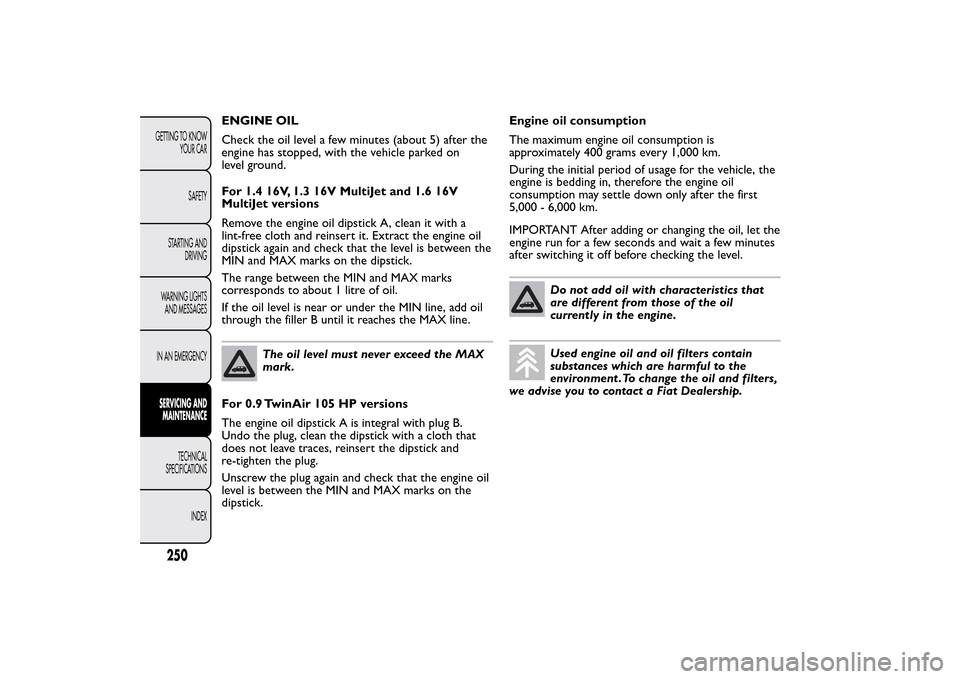
ENGINE OIL
Check the oil level a few minutes (about 5) after the
engine has stopped, with the vehicle parked on
level ground.
For 1.4 16V, 1.3 16V MultiJet and 1.6 16V
MultiJet versions
Remove the engine oil dipstick A, clean it with a
lint-free cloth and reinsert it. Extract the engine oil
dipstick again and check that the level is between the
MIN and MAX marks on the dipstick.
The range between the MIN and MAX marks
corresponds to about 1 litre of oil.
If the oil level is near or under the MIN line, add oil
through the filler B until it reaches the MAX line.
The oil level must never exceed the MAX
mark.
For 0.9 TwinAir 105 HP versions
The engine oil dipstick A is integral with plug B.
Undo the plug, clean the dipstick with a cloth that
does not leave traces, reinsert the dipstick and
re-tighten the plug.
Unscrew the plug again and check that the engine oil
level is between the MIN and MAX marks on the
dipstick.Engine oil consumption
The maximum engine oil consumption is
approximately 400 grams every 1,000 km.
During the initial period of usage for the vehicle, the
engine is bedding in, therefore the engine oil
consumption may settle down only after the first
5,000 - 6,000 km.
IMPORTANT After adding or changing the oil, let the
engine run for a few seconds and wait a few minutes
after switching it off before checking the level.
Do not add oil with characteristics that
are different from those of the oil
currently in the engine.Used engine oil and oil filters contain
substances which are harmful to the
environment .To change the oil and filters,
we advise you to contact a Fiat Dealership.
250GETTING TO KNOW
YOUR CAR
SAFETY
STARTING AND
DRIVING
WARNING LIGHTS
AND MESSAGES
IN AN EMERGENCYSERVICING AND
MAINTENANCE
TECHNICAL
SPECIFICATIONS
INDEX
Page 255 of 420
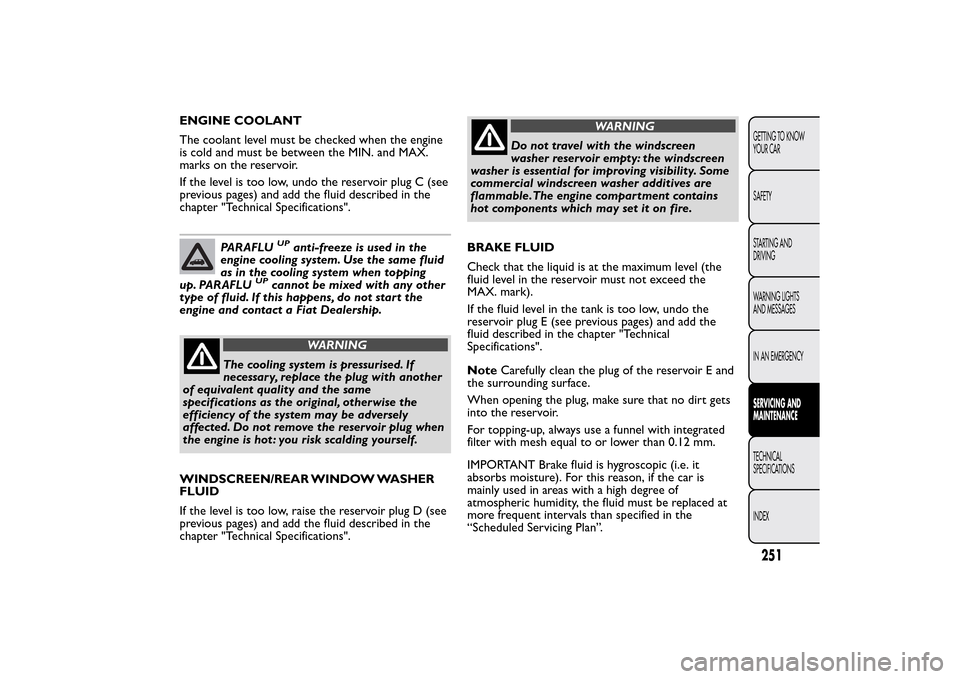
ENGINE COOLANT
The coolant level must be checked when the engine
is cold and must be between the MIN. and MAX.
marks on the reservoir.
If the level is too low, undo the reservoir plug C (see
previous pages) and add the fluid described in the
chapter "Technical Specifications".
PARAFLU
UP
anti-freeze is used in the
engine cooling system. Use the same fluid
as in the cooling system when topping
up. PARAFLU
UP
cannot be mixed with any other
type of fluid. If this happens, do not start the
engine and contact a Fiat Dealership.
WARNING
The cooling system is pressurised. If
necessary, replace the plug with another
of equivalent quality and the same
specifications as the original, otherwise the
efficiency of the system may be adversely
affected. Do not remove the reservoir plug when
the engine is hot : you risk scalding yourself.
WINDSCREEN/REAR WINDOW WASHER
FLUID
If the level is too low, raise the reservoir plug D (see
previous pages) and add the fluid described in the
chapter "Technical Specifications".
WARNING
Do not travel with the windscreen
washer reservoir empty: the windscreen
washer is essential for improving visibility. Some
commercial windscreen washer additives are
flammable.The engine compartment contains
hot components which may set it on fire.
BRAKE FLUID
Check that the liquid is at the maximum level (the
fluid level in the reservoir must not exceed the
MAX. mark).
If the fluid level in the tank is too low, undo the
reservoir plug E (see previous pages) and add the
fluid described in the chapter "Technical
Specifications".
NoteCarefully clean the plug of the reservoir E and
the surrounding surface.
When opening the plug, make sure that no dirt gets
into the reservoir.
For topping-up, always use a funnel with integrated
filter with mesh equal to or lower than 0.12 mm.
IMPORTANT Brake fluid is hygroscopic (i.e. it
absorbs moisture). For this reason, if the car is
mainly used in areas with a high degree of
atmospheric humidity, the fluid must be replaced at
more frequent intervals than specified in the
“Scheduled Servicing Plan”.
251GETTING TO KNOW
YOUR CAR
SAFETY
STARTING AND
DRIVING
WARNING LIGHTS
AND MESSAGES
IN AN EMERGENCYSERVICING AND
MAINTENANCETECHNICAL
SPECIFICATIONS
INDEX
Page 257 of 420
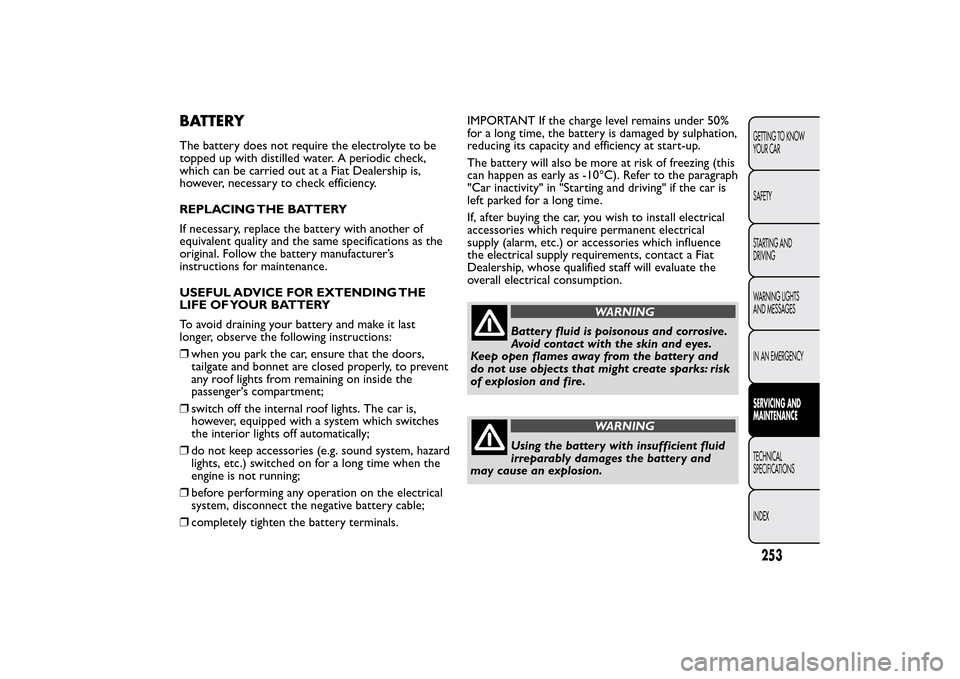
BATTERYThe battery does not require the electrolyte to be
topped up with distilled water. A periodic check,
which can be carried out at a Fiat Dealership is,
however, necessary to check efficiency.
REPLACING THE BATTERY
If necessary, replace the battery with another of
equivalent quality and the same specifications as the
original. Follow the battery manufacturer’s
instructions for maintenance.
USEFUL ADVICE FOR EXTENDING THE
LIFE OF YOUR BATTERY
To avoid draining your battery and make it last
longer, observe the following instructions:
❒when you park the car, ensure that the doors,
tailgate and bonnet are closed properly, to prevent
any roof lights from remaining on inside the
passenger's compartment;
❒switch off the internal roof lights. The car is,
however, equipped with a system which switches
the interior lights off automatically;
❒do not keep accessories (e.g. sound system, hazard
lights, etc.) switched on for a long time when the
engine is not running;
❒before performing any operation on the electrical
system, disconnect the negative battery cable;
❒completely tighten the battery terminals.IMPORTANT If the charge level remains under 50%
for a long time, the battery is damaged by sulphation,
reducing its capacity and efficiency at start-up.
The battery will also be more at risk of freezing (this
can happen as early as -10°C). Refer to the paragraph
"Car inactivity" in "Starting and driving" if the car is
left parked for a long time.
If, after buying the car, you wish to install electrical
accessories which require permanent electrical
supply (alarm, etc.) or accessories which influence
the electrical supply requirements, contact a Fiat
Dealership, whose qualified staff will evaluate the
overall electrical consumption.
WARNING
Battery fluid is poisonous and corrosive.
Avoid contact with the skin and eyes.
Keep open flames away from the battery and
do not use objects that might create sparks: risk
of explosion and fire.
WARNING
Using the battery with insufficient fluid
irreparably damages the battery and
may cause an explosion.
253GETTING TO KNOW
YOUR CAR
SAFETY
STARTING AND
DRIVING
WARNING LIGHTS
AND MESSAGES
IN AN EMERGENCYSERVICING AND
MAINTENANCETECHNICAL
SPECIFICATIONS
INDEX
Page 265 of 420
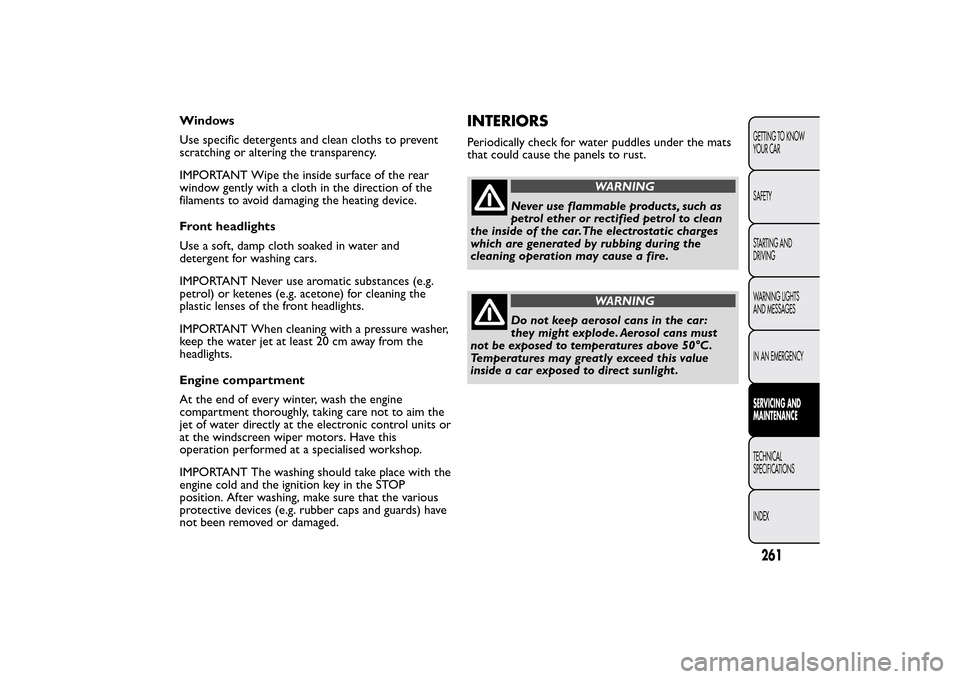
Windows
Use specific detergents and clean cloths to prevent
scratching or altering the transparency.
IMPORTANT Wipe the inside surface of the rear
window gently with a cloth in the direction of the
filaments to avoid damaging the heating device.
Front headlights
Use a soft, damp cloth soaked in water and
detergent for washing cars.
IMPORTANT Never use aromatic substances (e.g.
petrol) or ketenes (e.g. acetone) for cleaning the
plastic lenses of the front headlights.
IMPORTANT When cleaning with a pressure washer,
keep the water jet at least 20 cm away from the
headlights.
Engine compartment
At the end of every winter, wash the engine
compartment thoroughly, taking care not to aim the
jet of water directly at the electronic control units or
at the windscreen wiper motors. Have this
operation performed at a specialised workshop.
IMPORTANT The washing should take place with the
engine cold and the ignition key in the STOP
position. After washing, make sure that the various
protective devices (e.g. rubber caps and guards) have
not been removed or damaged.
INTERIORSPeriodically check for water puddles under the mats
that could cause the panels to rust.
WARNING
Never use flammable products, such as
petrol ether or rectified petrol to clean
the inside of the car.The electrostatic charges
which are generated by rubbing during the
cleaning operation may cause a fire.
WARNING
Do not keep aerosol cans in the car:
they might explode. Aerosol cans must
not be exposed to temperatures above 50°C .
Temperatures may greatly exceed this value
inside a car exposed to direct sunlight .
261GETTING TO KNOW
YOUR CAR
SAFETY
STARTING AND
DRIVING
WARNING LIGHTS
AND MESSAGES
IN AN EMERGENCYSERVICING AND
MAINTENANCETECHNICAL
SPECIFICATIONS
INDEX
Page 412 of 420
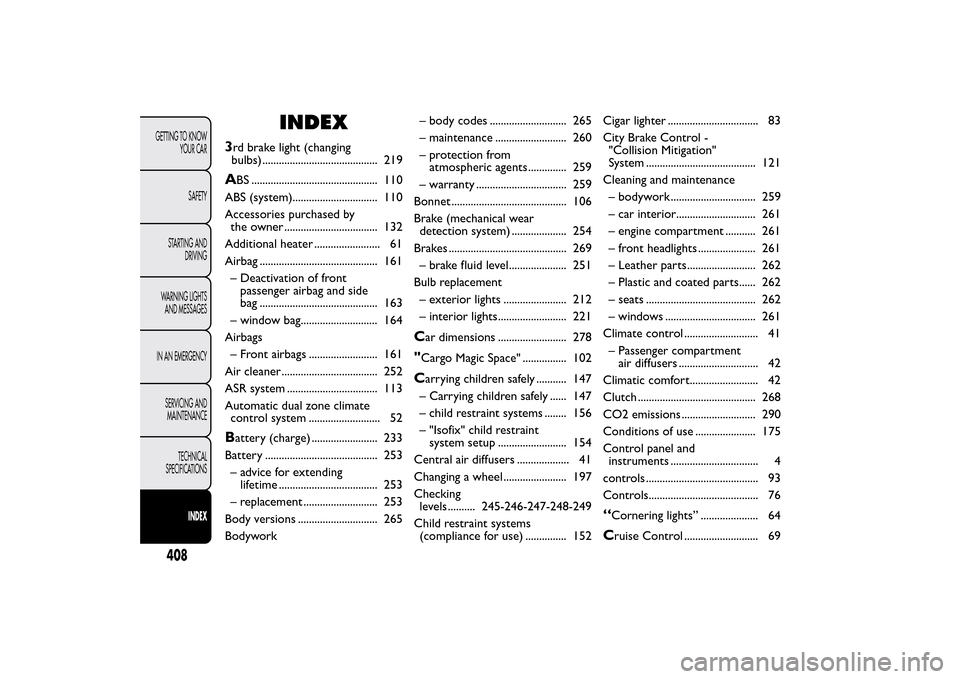
INDEX
3rd brake light (changing
bulbs) .......................................... 219A
BS .............................................. 110
ABS (system)............................... 110
Accessories purchased by
the owner .................................. 132
Additional heater ........................ 61
Airbag ........................................... 161
– Deactivation of front
passenger airbag and side
bag ........................................... 163
– window bag............................ 164
Airbags
– Front airbags ......................... 161
Air cleaner ................................... 252
ASR system ................................. 113
Automatic dual zone climate
control system .......................... 52
Battery (charge) ........................ 233
Battery ......................................... 253
– advice for extending
lifetime .................................... 253
– replacement ........................... 253
Body versions ............................. 265
Bodywork– body codes ............................ 265
– maintenance .......................... 260
– protection from
atmospheric agents.............. 259
– warranty ................................. 259
Bonnet .......................................... 106
Brake (mechanical wear
detection system) .................... 254
Brakes ........................................... 269
– brake fluid level..................... 251
Bulb replacement
– exterior lights ....................... 212
– interior lights......................... 221
Car dimensions ......................... 278"Cargo Magic Space" ................ 102Carrying children safely ........... 147
– Carrying children safely ...... 147
– child restraint systems ........ 156
– "Isofix" child restraint
system setup ......................... 154
Central air diffusers ................... 41
Changing a wheel ....................... 197
Checking
levels .......... 245-246-247-248-249
Child restraint systems
(compliance for use) ............... 152Cigar lighter ................................. 83
City Brake Control -
"Collision Mitigation"
System ........................................ 121
Cleaning and maintenance
– bodywork ............................... 259
– car interior............................. 261
– engine compartment ........... 261
– front headlights ..................... 261
– Leather parts......................... 262
– Plastic and coated parts...... 262
– seats ........................................ 262
– windows ................................. 261
Climate control ........................... 41
– Passenger compartment
air diffusers ............................. 42
Climatic comfort......................... 42
Clutch ........................................... 268
CO2 emissions ........................... 290
Conditions of use ...................... 175
Control panel and
instruments ................................ 4
controls ......................................... 93
Controls........................................ 76
“Cornering lights” ..................... 64Cruise Control ........................... 69
408GETTING TO KNOW
YOUR CAR
SAFETY
STARTING AND
DRIVING
WARNING LIGHTS
AND MESSAGES
IN AN EMERGENCY
SERVICING AND
MAINTENANCE
TECHNICAL
SPECIFICATIONS
INDEX